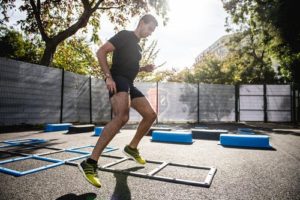How to start a workout routine when you are overweight

Article by: David Dack
Starting an exercise plan as an overweight person is no easy feat. If you’re carrying around a lot of extra weight, certain exercises may be physically uncomfortable or too painful to perform. This makes sticking to a long term fitness plan out of reach.
But it’s worth the sweat.
Being overweight, especially if you fall into the “obese” category, means that you are at risk for many health conditions, such as heart disease, blood pressure, stroke, type II diabetes, and some cancers.
Guess what’s the best way to reduce your risks for these diseases and (re) gain control over your health?
Of course, exercise. That’s where today’s post comes in handy. The following measures will increase your chances of being more successful in your exercise endeavors.
Sounds great?
Let’s get started…
Walk first
When you’re trying to form the exercise habit, it’s never a good idea to commit too much from the get-go. That’s why if you’ve been sedentary lately, invest a few weeks into a walking program first to introduce some movement into your daily life.
For the first few weeks, go for 30 to 45 minutes walks at a brisk pace three times per week. As you get fitter, feel free to lengthen your walks—you can also add in a few jogging segments, following a walk/run strategy.
Make Your Goals More Specific
To ensure fitness success, your goals should be well-defined and specific — no room for ambiguity. The more specific your goals are, the more likely you’ll be able to push through, even when all the odds are stacked up against you.
Whether it’s being able to run a 5K in 8 weeks, losing 10 pounds in three months, or being able to do 50 push-ups before the end of the year, achieving your fitness goals motivates you to stick to your training routine.
Get The Right Gear
Look for high-performance gear—as in clothing specifically designed for exercise—that fits well, comfortable, and is within your budget, especially when it comes to your footwear.
If you’re obese, the extra pounds and stress on your muscles and joints can make you even more prone to injuries, so it’s essential to find the proper sneakers for you.
Follow a Training program
A plan will set you up for long term success—whether you opt to work out in the morning, during your lunch break, or later in the evening.
Once you decide on a schedule, enter it into your cellphone calendar as a repeat event. Next, schedule your workouts just like you’d a work meeting, family gathering, or doctor’s appointment. By doing this, there will be a chance of you scheduling an event during that time.
What kind of exercise would I recommend for a beginner?
After a few weeks into your walking program, you should lift some weights. Strength training will help you lose weight and build muscle without putting too much stress on your body.
Warm-up
Okay, so you’ve dragged yourself into a gym. What should you try first?
Don’t think about doing any strength training yet. First, find an open area and perform a thorough warm-up.
A proper warm-up increases cardiac output, improves nerve signal transmission, tissue pliability, and muscle coordination via movement rehearsal.

Start with a 5-minute warm-up of brisk walking, light jogging, or running in place. Then follow it with 5 to 10 minutes of dynamic stretches. These use controlled movements to increase your range of motion and loosen up your muscles. Try doing some butt kicks, inchworms, walking lunges, push-ups, squats, etc.
Conclusion
There you have it. The above guidelines are all you need to get start exercising . Now it’s up to you to start doing what you should have been doing a long time. The rest is just details.
Please feel free to leave your comments and questions in the section below. Can’t wait to hear from you.
In the meantime, thank you for dropping by.
About the author:David Dack is an established fitness blogger and running expert. When he’s not training for his next marathon, he’s doing research and trying to help as many people as possible to share his fitness philosophy. Check his blog Runners Blueprint for more info.










